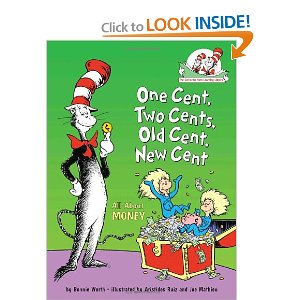Teaching Your Child about Money through Play and Positive Interaction

I’m the Cat in the Hat
And you want to know something funny?
We’re about to have fun
Learning all about money!
-from the Cat in the Hat’s Learning Library
Young children learn through play. They learn about relationships and resolving conflicts. They learn about gender roles and explore occupational choices by playing house, school, doctor, nurse, fireman, cops and robbers, and so on. Children can pretend and imagine for hours on end, with or without the help of props, puppets, costumes and equipment. Engaging in play activities helps a child reduce anxiety, because the child in play is working hard at resolving subconscious conflicts through play.
Children also enjoy positive attention from their parents. There is nothing more rewarding than engaging in play with your child for thirty minutes each day; rewarding for you and your child because it reduces a child’s attention seeking behaviors and anxiety! The best way to reduce negative interactions with your child is to increase positive ones.
During play, it is important that the parent join with the child and allow the child to direct the play, as long as the child is playing safely and appropriately. If the child is not appropriate, an “if, then” statement can be made to instruct the child that “if you want to keep playing, then you’ll need to (correct the problem behavior).” If the problem behavior persists, and the child is not responding to correction, a parent can assert that playtime is over, and disengage from play. You can express your hope that tomorrow’s play time will be more fun. The natural consequence for bad play behavior is that no one wants to play with you!
While behavior is appropriate, the parent can use positive reflective statements to boost the child’s self esteem and self confidence, and establish a positive relationship bond. An example of a reflective statement would be, “You decided to play with the blocks instead of the cars.” Other active listening techniques can be used when the child responds. For example, the child might say, “I played with the cars yesterday.” An active listening response could include, “Oh, I see. Since you played cars yesterday, you want to play with the blocks today.” During this time, it is important that the child be allowed to take the lead, and that the parent refrain from criticism and correction (except as noted above regarding safety). Concerns can be addressed, if needed, outside of play time.
Introducing books and toys about money is one way to attract interest in the topic of money and to begin to explore some values related to money. It provides an opportunity for parents to consider their own knowledge and values related to money, too! Through play children can learn to manage money, make career choices, learn to control impulses, learn the relationship between work and money, solve money problems, manage money related anxiety, and develop interest and motivation to learn more about math, money, business, sales, customer service, finance, banking, marketing, management and accounting. Girls can explore alternatives to teaching and nursing as career choices. Boys can learn alternatives to fireman, policeman and professional athlete.
Children can learn about lifestyle balance through play; that while money play is fun, so is playing house and school and cars and sports! They can also learn that people have worth regardless of the career they choose or how much money they make. They can learn that it feels good to earn money from work, and that work is honorable.
They can learn that love and respect are free, and are valuable too. They can learn to value that when someone else works hard to own something, it’s not ok to take it or destroy it. They learn about property rights and protecting property. They learn that people and property are not the same, but both are worthy of respect. They learn about self respect when they are treated with respect, and are allowed to express themselves in play!
These are all themes that can emerge in play with a child! Children learn a lot from play. They learn a lot from parents too – more from what parents do than what they say. A parent who spends time in play with a child is teaching a child that they are worthy of attention and that their ideas are worthwhile as well.
There are merchandise selections throughout this hub that are intended as suggestions. Spending a lot of money, of course, isn’t necessary to show love, enjoy play, use imagination or spend quality time with your child. Play money can still be made with paper and pencil, and a lemonade stand can be just as much fun with an empty box or a table top. The library still has lots of free books, and there are plenty of children’s’ shows on TV.











